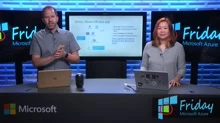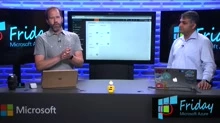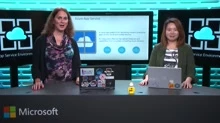Azure Files, Azure Monitor, Management and Governance, Storage
Last week in Azure for the week of October 9, 2017
Posted on
3 min read
1. IoT updates
Now you can monitor your Azure IoT solutions with Azure Monitor and Azure Resource Health. Azure Monitor provides highly granular and real-time monitoring data for any Azure resource. Check out this video on Channel 9 to Get Started with Azure Monitor. Azure resouce health is your personalized dashboard of how your resources are doing based on a series of executed checks, such as checking if the IoT hub is up and running.
Azure IoT Hub now supports X.509 CA certificates for device identity. The use of X.509 certificate authority (CA) certificates dramatically simplifies device identity creation and life-cycle management in the supply chain, which enables registration of any number of devices into Azure IoT Hub by registering an X.509 CA certificate once; otherwise, device-unique certificates must be pre-registered for every device before it can connect. For more information, see Device Authentication using X.509 CA Certificates.
2. New previews
- Azure Files share snapshots – Azure Files share snapshots enables you to store periodically read-only versions of your file shares. It also enables you to copy an older version of your content from anywhere for further modification and use.
- Batch AI – Now you can provision clusters of GPUs or CPUs on demand to train your models in parallel and at scale in Azure. If you want to give it a try, you can run recipes using the Python quickstart or the Azure CLI 2.0 quickstart. Or, you can try out the Azure Batch AI training recipes in GitHub. For more information, see Azure Batch AI.
3. Azure Management Libraries for .NET v1.3
The latest release of the Azure Management Libraries for .NET adds support for availability zones (in preview), as well as support for Network Peering, Virtual Network Gateway and Azure Container Instances. You can find .NET sample code that addresses just about every Azure management scenario you can imagine on GitHub.
4. Cloud Platform Release Announcements
Every few weeks (usually on a Wednesday), we publish a consolidated list of updates for that period from the Cloud Platfrom team at Microsoft, which includes Azure, dev tools, and more. The Cloud Platform Release Announcements for October 11, 2017 post from last week covers everything that was released after Microsoft Ignite 2017, such as public preview of Java support in Azure Functions and general availability of Power BI Embedded.
5. Stuff to watch & Listen
-
Azure Friday: ILB ASE and Application Gateway – Christina Compy joins Scott Hanselman to talk about exposing your internet-isolated apps with an Application Gateway. This enables you to securely host multi-tier applications on an Internal Load Balancer (ILB) App Service Environment (ASE) and only expose the front-end applications that you want to expose.
-
Azure Friday: Jenkins Plugins for Kubernetes – Pui Chee “PC” Chan joins Scott Hanselman to discuss native support for Jenkins in Azure. Our plugins make it easy for you to build your project using a container agent and then automate deployment from Jenkins to an Azure Container Service Kubernetes cluster.
-
Azure Friday: Azure Instance Metadata Service – Hariharan Jayaraman joins Scott Hanselman to talk about the Azure Instance Metadata Service, which provides information about running virtual machine instances that you can use to manage and configure your virtual machines. Use the service to get information such as SKU, network configuration, and upcoming maintenance events.
-
The Azure Podcast: Episode 199 – Blockchain Update – Cale Teeter gives us the latest scoop on all the things Microsoft is doing in the Blockchain space. Plus, more coverage of the updates mentioned earlier in this post.
-
Cloud Tech 10 – 16th October 2017 – Batch AI, Durable Functions, File Share Snapshots and more! – In this rapid-fire video series from Mark Whitby, a Cloud Solution Architect at Microsoft UK, you get a weekly dose of how-to information in 10 minutes or less.
-
Azure Application Service Environments v2: Private PaaS Environments in the Cloud – An App Service Environment v2 is a fully isolated and dedicated environment for securely running Azure App Service apps at high scale, including Web Apps, Mobile Apps, and API Apps. It is essentially a deployment of the Azure App Service into a subnet of your network, so think of it as your private Platform-as-a-Service environment in the cloud.



